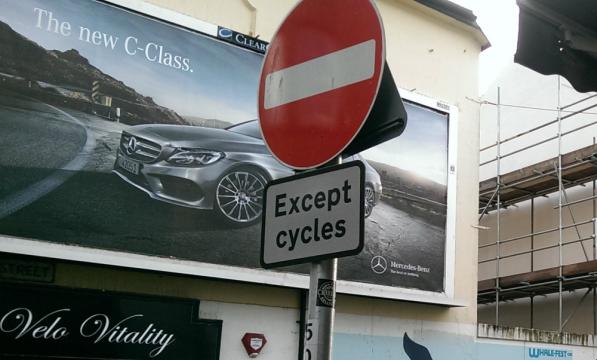More information about Traffic Regulation Orders

Cycling UK receives Traffic Regulation Orders (and other orders - e.g. those creating, diverting or extinguishing rights of way) from many local authorities around the country. Cycling UK's local campaigners are strongly encouraged to check on proposals for their area and respond if they affect cycling at all - either positively or negatively.
What are Traffic Regulation Orders (TROs) and what do they do?
- Essentially, a TRO is the legal instrument by which traffic authorities implement most traffic management controls in their area;
- In Greater London, they are normally known as Traffic Management Orders (TMOs);
- Orders are designed to regulate, restrict or prohibit the use of a road (or any part of the width of a road) by vehicular traffic or pedestrians. They can apply at all times or during specified periods, and certain classes of traffic can be exempted from them. (Cycles are counted as 'vehicular traffic);
- When implementing Orders, highway authorities have a duty in law “to secure the expeditious, convenient and safe movement of vehicular and other traffic (including pedestrians)”. (Section 122 of the Road Traffic Regulation Act 1984).
Why are they important for cyclists?
If implemented, certain Traffic Orders may well have an impact on cyclists - e.g. if they create one-way streets without allowing cyclists to ride two-way (contra-flow), thereby forcing them to use a busy and/or more hazardous alternative route.
If an authority's proposals are likely to affect cycling journeys in some way, they should (arguably) consult groups who represent cyclists (e.g. Cycling UK and through us, our local campaigners) before they implement the Order; and, in any case, anyone has the right to object, even if they haven't been directly consulted - hence the importance of local cyclists looking out for notices telling the public about any Orders that the authority is thinking of making. Fortunately, an authority has a duty to publish Orders (e.g. in the media, on the council's website, at the site itself, etc.), so that the road users and the general public do have the chance to consider them and object if they so wish.
What is the relevant legislation?
- Authorities have the power to implement Orders under the Road Traffic Regulation Act 1984 (RTRA). This Act applies to England, Wales and Scotland, although there are a few variations in the Act relating to Scotland;
- TROs outside London are governed by section 1 of the RTRA;
- In Greater London, TMOs are governed by section 6 of the RTRA;
- The procedure for making Orders in England and Wales is set out in the Local Authorities' Traffic Orders (Procedure) (England and Wales) Regulations 1996 (SI 1996/2489), as amended - (LATO)
- The procedure for making Orders in Scotland is set out in the Local Authorities' Traffic Orders (Procedure) (Scotland) Regulations 1999 (SI 1999/614), as amended - (LATO-S).
Who can implement an Order?
County councils, metropolitan district councils and London boroughs all have powers to make these Orders in their areas (as long as they are responsible for the highway(s) in question). The Secretary of State has similar powers with respect to trunk roads.
What are the different types of Order?
- Permanent Orders, which remain in force until superseded or revoked;
- Experimental Orders, which may last for up to 18 months, with extensions available in certain circumstances.
- Temporary orders (for road works, or the avoidance of danger to the public, or for litter clearance and cleaning) which may last for: up to six months for footpaths, bridleways, cycle tracks and byways open to all traffic; and up to 18 months on other roads, with extensions available in certain circumstances.
Why do authorities implement Orders?
There are lots of possible reason, e.g.:
- Avoiding danger to persons or traffic;
- Preventing use by unsuitable traffic;
- Specifying through routes for HGVs (i.e. any goods vehicle above 7.5 tonnes)
- Prohibiting or restricting HGVs in certain zones or on certain roads;
- Preventing damage to the road or to buildings nearby;
- Facilitating the passage of traffic;
- Preserving the character of a road especially suitable for walking or horse riding;
- Preserving or improving amenities of the area through which the road runs;
- Parking restrictions on specific roads (but not a general parking prohibition, which is subject to separate legislation);
- For any of the purpose specified in paragraphs (a) to (c) of the Environment Act 1995 in relation to air quality;
- Temporary closures for parades etc.
Orders can also be made for roads in special areas of the countryside (e.g. National Parks) for the purpose of conserving or enhancing the natural beauty of the area. Additionally, Orders can be implemented to allow for improved access to recreational opportunities or to provide for the study of nature.
What effect can an Order have on pedestrian and vehicular access?
An Order must not have the effect of preventing pedestrian access at any time, or preventing vehicular access for more than eight hours in 24 to premises on or adjacent to the road. However, this restriction does not apply if the local authority states in the Order that they require vehicular access to be limited for more than eight hours in 24. In these cases, the agreement of the Secretary of State is usually required.
What must a local authority do prior to implementing an Order?
Permanent Orders are subject to LATO and LATO-S regulations (see above). These impose various legal requirements prior to making an Order, for example:
- publishing a notice of the proposals in a local newspaper (although the Government is considering the implications of specifying alternative media for advertising instead, e.g. less costly electronic methods);
- allowing potential objectors 21 days to make representations;
- taking other steps the authority may consider appropriate for ensuring adequate publicity is given to persons likely to be affected by any provision in the order (including roadside notices and delivery of letters to premises); and
- holding a public inquiry if the Order would prohibit loading or unloading of vehicles (i) at all times, (ii) before 07.00 hours, (iii) between 10.00 and 16.00; or (iv) after 19.00, or if the passage of public service vehicles would be restricted. (The authority may opt to hold a public inquiry in other circumstances).
Who needs to be consulted before an Order is implemented?
Before an Order is implement, the authority has to consult the police along with the Freight Transport Association and Road Haulage Association. They must also consult: “Such other organisations (if any) representing persons likely to be affected by any provision in the order as the order making authority thinks it appropriate to consult” (LATO regs clause 6).
Temporary TROs/TMOs: There is no requirement to consult on Temporary Orders (e.g. to amend normal traffic regulations while road works are taking place), other than to consult the National Park Authority for any National Park that might be affected.
However, in making a Temporary Order, “an authority shall have regard to the existence of alternative routes suitable for the traffic which will be affected by the order or notice” (section 14 of RTRA).
Who may object to an Order?
Any person may object to an Order. The traffic authority is obliged to consider objections (and, if a public inquiry is held, the Inspector's recommendations) before deciding whether or not to make the Order.
Experimental Orders: When making experimental TRO/TMOs, the local authority still has a duty to consult, but is not required to consider objections until it is deciding whether to make the experiment permanent (i.e. normally towards the end of the period of the experiment). (Section 9, of RTRA and sections 22-24 of the LATO regs for England & Wales; section 20 of the LATO regs for Scotland).
What must be done once an Order is made?
Once an Order is made, the regulations require (amongst other things) that:
- a notice to that effect be published in a local newspaper;
- that objectors be notified in writing of the decision (and, where the objections have not been acceded-to, the reasons for it);
- other publicity steps be taken as the authority considers appropriate; and
- the requisite traffic signs are placed on or near the road and maintained for as long as the Order remains in force.
Further reading:
House of Commons Library: standard note on TROs (Nov. 2014)
External links and supporting documents for Traffic Regulation Orders.
New Roads and Street Works Act [Legislation]
Road Signs Regulations and General Directions [Legislation]
Road Traffic Regulation (Special Events) Act [Legislation]
Road Traffic Regulation Act [Legislation]
Safety at Street Works and Road Works, A Code of Practice [Department for Transport]
Traffic Management Act [Legislation]
Traffic Signs Manual Chapter 8, Traffic Safety Measures and Signs for Road Works and Temporary Situations – Part 1: Design and Part 2: Operations [TSO ISBN 0-11-552738 9 & 0-11-552739 7]
Working Together: A good Practice Guide to Managing Works in the Street [Department for Transport]
New Roads and Street Works Act 1991 – Code of Practice for the Co-ordination of Street Works and Works for Road Purposes and Related Maters. Third Edition July 2007
The Local Authorities' Traffic Orders (Procedure) (England and Wales) Regulations 1996: these regulations prescribe the procedure to be followed by local authorities in England and Wales for making the main types of traffic and parking orders.
The Local Authorities' Traffic Orders (Procedure) (Scotland) Regulations 1999: these regulations prescribe the procedure for authorities in Scotland



